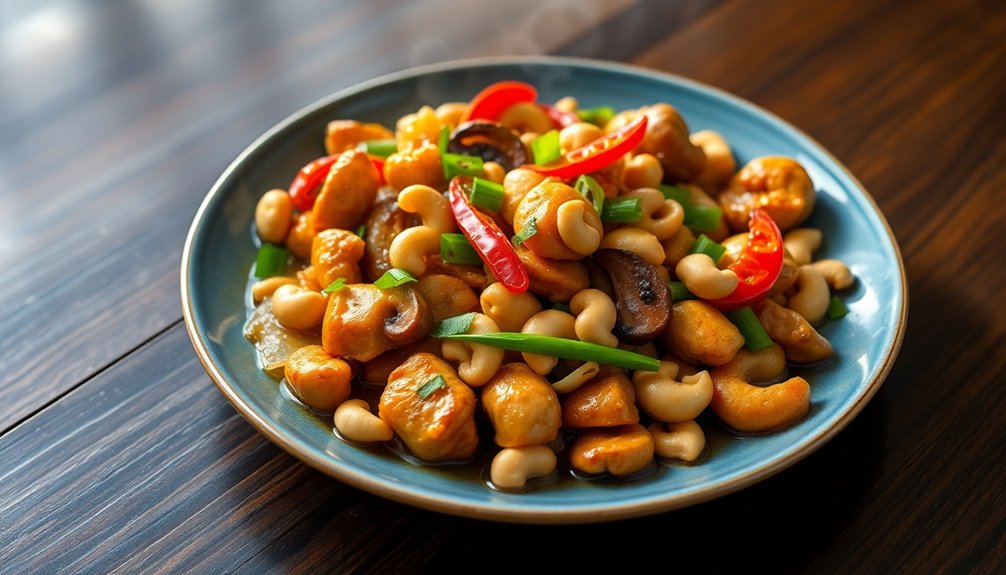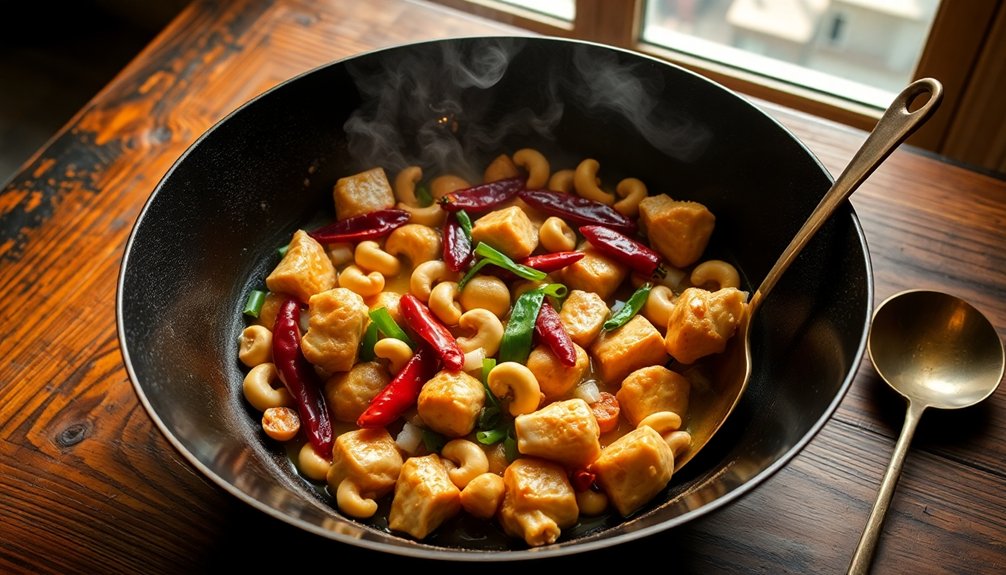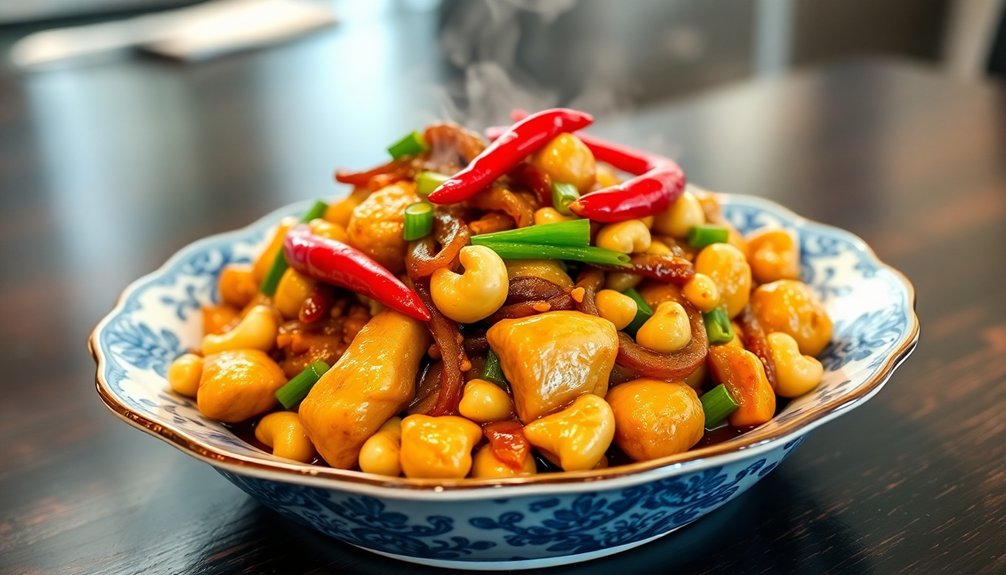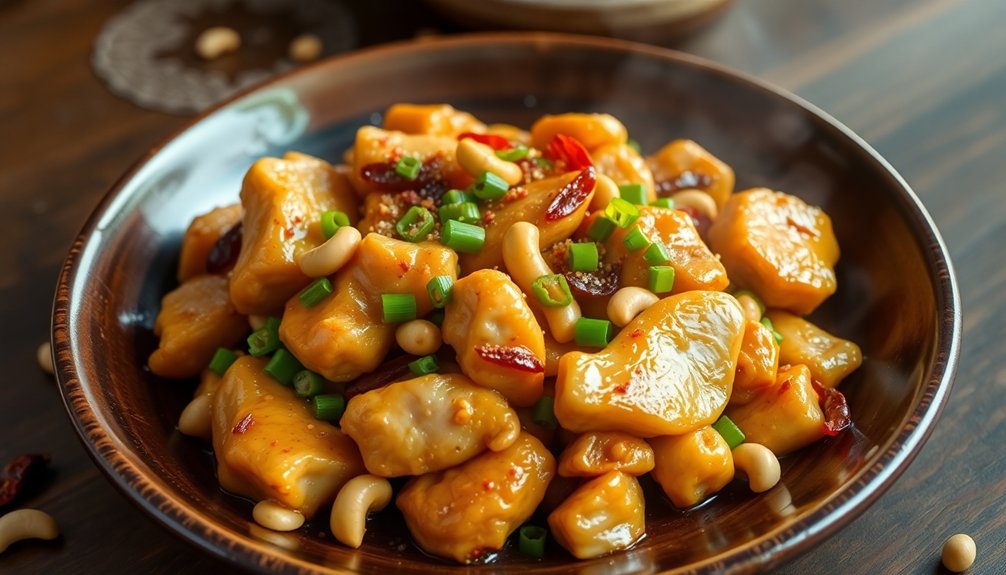How To make Gai Pad Med Mamuang - Stir-Fried Chicken With Cashew Nuts
To make authentic Gai Pad Med Mamuang, marinate bite-sized chicken pieces in oyster sauce, soy sauce, and white pepper for 15-30 minutes. Heat your wok until smoking, then stir-fry cashews and dried chilies until golden. Cook the chicken until browned, add mixed vegetables, and pour in the sauce mixture, stirring continuously. The key lies in controlling wok heat and timing each component – master these elements, and you’ll reveal the true essence of Thai cashew chicken.
Key Takeaways
- Marinate bite-sized chicken pieces in oyster sauce, soy sauce, and white pepper for 15-30 minutes before cooking.
- Toast cashews and dried chilies in hot oil until golden brown, then set aside while preparing other ingredients.
- Stir-fry marinated chicken until browned, then add mixed vegetables like onions, bell peppers, and carrots.
- Add sauce mixture of oyster sauce, soy sauce, and sugar, stirring continuously until all ingredients are well-coated.
- Combine toasted cashews with the chicken mixture, ensuring even distribution while maintaining the nuts’ crunchiness.

History

Though its exact origins are debated, Gai Pad Med Mamuang emerged in Thailand during the mid-20th century as Chinese culinary influences merged with Thai cooking techniques. This fusion dish exemplifies how Thai cuisine evolved by incorporating foreign ingredients while maintaining its distinctive flavors and cooking methods.
The dish’s cultural significance stems from cashews being considered a luxury ingredient in Thailand, making it a popular choice for special occasions and restaurant menus.
You’ll find that the balance of sweet, savory, and spicy elements reflects traditional Thai culinary principles, while the quick stir-frying method shows Chinese influence. The combination of cashews with chicken became a staple in Thai-Chinese restaurants, eventually spreading throughout Thailand and gaining international recognition as a beloved example of Thai cuisine’s adaptability.
Recipe

Recipe
Ingredients:
- 1 lb chicken breast, cut into bite-sized pieces
- 1 cup cashew nuts
- 2 cups mixed vegetables (onions, bell peppers, carrots)
- 4-5 dried red chilies
- 3 cloves garlic, minced
- 2 green onions, chopped
- 2 tablespoons vegetable oil
Sauce:
- 2 tablespoons oyster sauce
- 1 tablespoon soy sauce
- 1 teaspoon sugar
- 1/2 teaspoon white pepper
- 1 tablespoon water
Instructions:
- Mix sauce ingredients in a small bowl; set aside.
- Heat oil in a wok over medium-high heat.
- Add cashews and dried chilies, stir-fry until cashews are golden brown (1-2 minutes). Remove and set aside.
- In the same wok, add garlic and stir-fry for 30 seconds.
- Add chicken pieces and cook until nearly done (4-5 minutes).
- Add mixed vegetables and stir-fry for 2-3 minutes.
- Pour in sauce mixture, return cashews and chilies to wok.
- Stir-fry everything together until well combined (1-2 minutes).
- Add green onions and toss briefly.
- Serve hot with steamed rice.
Cooking Steps

You’ll start by marinating the sliced chicken in a mixture of soy sauce, oyster sauce, and white pepper for 15 minutes while preparing your mise en place of chopped vegetables and whisked sauce ingredients.
Heat your wok until smoking, then quickly toast the cashews until golden brown before removing them and proceeding to stir-fry the marinated chicken in batches until each piece develops a caramelized exterior.
Finally, add your aromatics, sauce mixture, and vegetables to the wok, tossing vigorously over high heat until the sauce thickens and coats each ingredient evenly.
Step 1. Marinate Chicken in Sauce
The first key step in creating authentic gai pad med mamuang is marinating your chicken pieces.
Cut 1 pound of chicken breast into bite-sized chunks and combine with 2 tablespoons oyster sauce, 1 tablespoon soy sauce, and 1 teaspoon white pepper.
For marinade options, you can add 1 tablespoon Shaoxing wine or dry sherry to enhance the chicken flavors.
Mix the chicken thoroughly with the marinade and let it rest for 15-30 minutes at room temperature.
Don’t marinate longer than 30 minutes, as the proteins will start breaking down.
During this time, the chicken will absorb the savory umami notes from the oyster sauce while the soy sauce tenderizes the meat.
This brief marination guarantees your stir-fried chicken stays juicy and flavorful.
Step 2. Prepare Sauce and Vegetables
While your marinated chicken rests, prepare a wok sauce by whisking together 3 tablespoons oyster sauce, 2 tablespoons light soy sauce, 1 tablespoon Shaoxing wine, 1 teaspoon sesame oil, and 1/2 teaspoon sugar until well combined.
The sauce consistency should be smooth and slightly thick.
For the vegetables, cut 1 medium onion into wedges, slice 2 scallions into 2-inch lengths, and roughly chop 1 red bell pepper. Peel and slice 3 cloves of garlic.
You’ll also need 1 cup of dried red chilies and 1 cup of roasted cashew nuts. This vegetable selection provides the perfect balance of textures and flavors typical in Thai cuisine.
Keep all ingredients separate and within reach of your wok, as the cooking process will move quickly.
Step 3. Stir-Fry Cashews Until Golden
Now that your mise en place is ready, heat your wok over high heat until wisps of smoke appear.
Add 2 tablespoons of vegetable oil and swirl to coat the sides. Carefully add your raw cashews in a single layer – they’ll release their natural oils while enriching your dish with heart-healthy fats and protein.
Keep the cashews moving constantly with your wok spatula using a circular motion. They’ll turn golden brown quickly, usually within 45-60 seconds.
Don’t let them burn, as this will create bitter flavors. Once they reach a deep golden color with a fragrant aroma, quickly remove them with a spider strainer or slotted spoon, letting excess oil drain back into the wok.
Set the cashews aside on paper towels to maintain their crispness.
Step 4. Stir-Fry Chicken Until Browned
Return your wok to high heat and add another tablespoon of oil, swirling to coat.
Once the oil begins to smoke slightly, add your marinated chicken pieces in a single layer. Let them sear undisturbed for 30 seconds to develop a golden-brown crust.
Using your wok spatula, quickly stir-fry the chicken using a lifting and tossing motion.
Continue stir-frying for 2-3 minutes until the chicken is nearly cooked through and shows even browning on all sides.
You’ll want to keep the chicken pieces moving constantly to prevent sticking and guarantee uniform cooking. The meat should be just slightly pink in the center at this stage, as it’ll finish cooking when combined with the other ingredients later.
Push the chicken to one side of the wok before proceeding to the next step.
Step 5. Add Sauce and Vegetables
Pour the prepared stir-fry sauce around the outer edge of your wok, allowing it to heat and caramelize against the hot metal. The sauce will begin to bubble and thicken within 30 seconds.
Add your sliced onions and bell peppers, tossing them quickly to coat with the sauce. For sauce variations, you can adjust the sweetness with palm sugar or add heat with extra chilies.
Next, toss in the dried red chilies and scallions, followed by the pre-soaked dried mushrooms. Your vegetable selection can include baby corn or water chestnuts for extra crunch.
Keep stirring continuously using a circular motion, letting the vegetables stay crisp-tender. Once the sauce coats everything evenly and has reduced slightly, you’re ready for the final step of adding the cashews.
Cooking Tips

When stir-frying Gai Pad Med Mamuang, controlling your wok’s heat is essential for achieving restaurant-quality results. Keep your flame on high and don’t overcrowd the wok, as this will cause the ingredients to steam rather than stir-fry.
Start with the chicken, cooking it until it’s just done, then set it aside.
If you can’t find dried chilies, substitute fresh Thai bird’s eye chilies, but reduce the amount by half. For the cashews, you’ll want to pre-toast them separately until golden brown.
When combining all ingredients, use quick, decisive cooking techniques – toss and stir rapidly to guarantee even coating of the sauce. Don’t overcook the onions and scallions; they should remain slightly crisp.
If oyster sauce isn’t available, you can use hoisin sauce, though the flavor profile will be slightly different.
Final Thoughts

Mastering Gai Pad Med Mamuang takes practice, but once you’ve perfected your wok technique and ingredient timing, you’ll create an authentic Thai cashew chicken that rivals your favorite restaurant’s version.
- While this dish is best served immediately, you can enjoy savoring leftovers within 24 hours – just store them in an airtight container and reheat in a wok for ideal texture.
- When pairing wines, consider a crisp Riesling or Gewürztraminer to complement the dish’s sweet and savory notes.
- Keep refining your wok skills by adjusting heat levels and timing – you’ll notice the difference in how the cashews toast and the sauce caramelizes.
Frequently Asked Questions
Can I Substitute Cashews With Other Nuts in This Dish?
If you’ve got nut allergies or prefer alternatives, you can use roasted peanuts, macadamias, or almonds, though they’ll alter the authentic flavor profile of this classic Thai dish.
How Long Can I Store Leftover Gai Pad Med Mamuang?
Food safety experts say 90% of cooked dishes spoil after 4 days. You’ll want to store your leftovers in an airtight container for 2-3 days maximum. Reheat in a wok until steaming hot.
Is This Dish Traditionally Spicy in Thai Restaurants?
You’ll find spicy variations in Thai restaurants, though it’s traditionally mild to medium-hot. Most places offer customizable heat levels, and restaurant adaptations often include dried chilies and chili paste.
What’s the Best Rice Type to Serve With This Dish?
While fancy foodies might insist on premium jasmine, you’ll find plain white rice works perfectly. For the best results, serve with Thai jasmine rice or try cauliflower rice for low-carb alternatives.
Can I Make This Dish Vegetarian by Replacing Chicken?
You can substitute tofu, seitan, or tempeh as vegetarian protein options. Marinate them in soy sauce and white pepper to enhance flavor. Make certain you press tofu well before wok-frying for best texture.
